Stuart Jeanne Bramhall's Blog: The Most Revolutionary Act , page 72
May 15, 2025
Under New Management
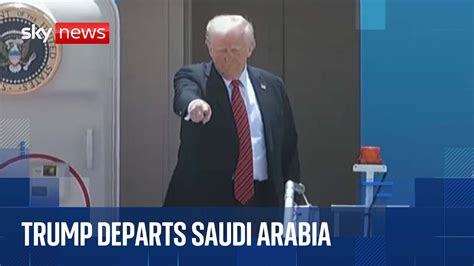
Under New Management
President Trump has wrapped up his trip to Saudi Arabia and the Western media is trying hard to ignore it. The main reason is they hate Trump, of course, but a secondary reason is they do not understand the importance of the trip. To them, it just looks like another foreign trip by a president. In reality it is a glimpse of how the large share owners of America Inc. are restructuring the company. The deals signed in Saudi Arabia are the first step in that restructuring.
For fifty years, the United States and Saudi Arabia had an agreement primarily centered around oil trade and the use of the U.S. dollar. The formal part of the agreement committed the Saudis to investing their profits from energy into U.S. Treasuries in exchange for American military commitments. The result was the Saudis priced everything in dollars, which led all other OPEC members to work in dollars, thus establishing the petrodollar concept.
The reason the dollar is the world’s reserve currency is it is backed with energy, the one thing everyone needs. The gold bugs like to say the dollar is “fiat currency” and is just colorful bits of paper, but that was always false. The dollar, like all real money, represents power. From the 1970’s to the present, the dollar represented the power of the United States and the power of hydrocarbons. Instead of money backed by shiny bits of metal, the dollar was backed by energy.
Another consequence of this arrangement is it provided an unlimited demand for dollar-denominated debt, especially treasuries. Because that debt is created within the American banking system, it made the United States the global bank. In effect, the petrodollar arrangement made the United States the world mint and the world’s banker, with the oil producing countries as the miners. With only one mint, it meant that the United States also controlled the mines.
This system has been under great pressure of late for a few reasons. One is the abuse of the system by the neocons in their foreign policy schemes. No one cared that much about using the financial system against small, nuisance countries like North Korea, but when the system was turned against big countries like Russia, one of the important mints, then people did care. The rise of BRICS as an off-dollar trading system was a response to the abuse of the system.
Another reason for the faltering dollar scheme is the Saudis decided to let the fifty-year-old agreement lapse. One reason for this is the abuse of the system by the neocons during the Biden years. The neocons were deliberately trying to destabilize the region in their war against Russia. This is not what the Saudis want. The other reason is the world is changing, and the Saudis need to adapt. They cannot continue to be a gas station in the desert. They need to diversify.
The biggest reason for the pressure on the petrodollar system is it hollowed out the American economy. It is not just the decline in manufacturing, which gets most of the attention, but also the decline in the nation’s infrastructure. This is becoming acute as the demand for electricity climbs. Artificial Intelligence may be oversold, but it is a real thing that will spike demand for electricity. Without trillions in new investments, the United States will not keep up with the world.
That last bit is the what the Saudi deal addresses. The Saudis are not going to plow their profits into treasuries, but into direct investments in the United States, while the United States provides support for Saudi Defense and infrastructure. This means the Saudis will be investing in American companies that are doing work inside the United States to build factories and infrastructure. The Saudis are not just a mint serving the American bank, but an investor in America Inc.
That is another thing easily missed about this trip. In the past, presidents went to Saudi Arabia to talk about military cooperation and the local politics. Business was delegated to Treasury and Commerce. The Treasury Secretary might make a trip to the region and meet his counterparts to discuss money. When a president visited these countries, money was not on the agenda. It was politics and the military situation in the places where America had stationed soldiers.
Notice on this trip that Scott Bessent was on the trip. Notice also that Bessent turns up in all of these foreign policy events. He led the charge on the so-called mineral deal with the Ukrainians. For the first time in a long time the bankers are now part of the foreign policy discussion. In fact, Bessent is involved in everything. He is part of the effort to root out some of the massive waste in government. What we are seeing is the return of political – economy to America Inc.
For several decades, at least, the managerial class has separated economics from politics, leaving the latter to the elected officials. Economics was too important to let the politicians get involved, so it was handled by experts. The result has been the perversion of economic policy. Instead of economic policy that benefits the people of the nation, we got policy that satisfied the theorists and the tiny minority that was able to arbitrage their access to the experts.
What this trip to Saudi Arabis represents is the return of political-economy where political decisions, including foreign policy, is measured against the standard of the national interests. Trump made that clear in his speech. He declared that foreign policy would no longer be about nation wrecking but about making deals that benefit the American people. Much as economics is being dragged from the abstract to the practical, foreign policy is being brought back to reality.
This trip also symbolizes the return of American Inc. The United States has never been a country in the traditional sense. It was always a business, something like a conglomerate containing many regional companies. The post-Cold War years were a monopoly phase, where managers stopped worrying about profits and focused on pet projects and social schemes. That time is done, and the company needs to be radically reformed to become competitive again.
Like all corporate restructurings, this one will fall far short of the dreams of the reformers, but whatever the result, it must be better than the alternative because the alternative is bankruptcy. In the case of empires, bankruptcy usually ends with the shareholders swinging from trees. The oligarchs of American seem to get this, which is why they are backing Trump and his turnaround team. Time will tell if American Inc. re-emerges as a strong company or a failed experiment.
[…]
Donald Trump Decouples the United States from Israel
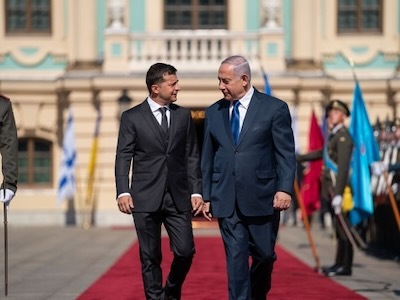
While he was the elected president of Ukraine, Volodymyr Zelensky and Prime Minister Benjamin Netanyahu, who was preparing to amend Israel’s Basic Laws—in other words, a coup d’état—were united. For three years, the two men have been advancing the agenda of the “revisionist Zionists”: they lie to the entire world and plunge the West into a war against Russia and the massacre of Palestinian civilians.
By Thierry Meyssan
The main obstacle Donald Trump faces in his peace negotiations, both with Iran and Ukraine, is the role of the “revisionist Zionists” now in power in Israel. [1] Two weeks ago, I presented in detail and with supporting evidence the pressure they are exerting on Washington to derail the talks with Tehran [2]. I did not address in my column on Voltairenet.org their pressure on behalf of the Ukrainian “integral nationalists” [3], which only became public on May 3, with Natan Sharansky’s emphatic statements in support of Volodymyr Zelensky [4].
I have already explained why and how these two groups formed an alliance in 1921 against the Bolsheviks and many Ukrainian Jews, which led to an investigation by the World Zionist Organization and the resignation of Vladimir Jabotinsky from its board of directors. This affair is today underestimated by Jewish historians who are reluctant to study the massacre of Jews by other Jews. There are, however, exceptions such as the work of Grzegorz Rossoliński-Liebe [5]. Sharansky himself prevents historians from studying the subject by presiding over the Babi Yar Holocaust Memorial Center (the shooting of 33,771 Jews on September 29 and 30, 1941) by the Einsatzgruppen and the “integral nationalists” two weeks after Stepan Bandera’s transfer from Kyiv to Berlin.
And let’s not forget the contacts of the “revisionist Zionists” with Adolf Eichmann until the fall of Berlin by the Red Army on May 2, 1945 [6].
While the then Israeli Prime Minister, Naftali Bennett, had, at the beginning of the Russian special operation in Ukraine, called on Volodymyr Zelensky to recognize Moscow’s just demands to “denazify Ukraine,” and Israeli Defense Minister Benny Gantz had declared that, while he was alive, Israel would never give weapons to the “massacres of Ukrainian Jews,” the current Prime Minister, Benjamin Netanyahu, authorized the Israeli arms industry to export its production to Ukraine.

[…]
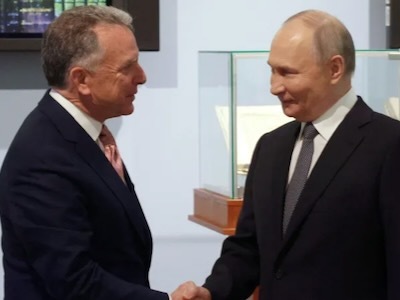 Real estate developer Steve Witkoff, who became his friend Donald Trump’s special envoy to the Greater Middle East, is of Jewish heritage. He perfectly understood what President Vladimir Putin told him about “revisionist Zionists” in Israel and “integral nationalists” in Ukraine, to the point that Westerners accused him of repeating the Russian narrative.
Real estate developer Steve Witkoff, who became his friend Donald Trump’s special envoy to the Greater Middle East, is of Jewish heritage. He perfectly understood what President Vladimir Putin told him about “revisionist Zionists” in Israel and “integral nationalists” in Ukraine, to the point that Westerners accused him of repeating the Russian narrative.[…]
In any case, if no one in the United States can question the alliance with Israel, this in no way implies support for the “revisionist Zionists” now in power in Tel Aviv.
[…]
Slowly, President Donald Trump is disassociating Israel from Benjamin Netanyahu. Receiving him at the White House while he was the subject of an arrest warrant from the International Criminal Court, he had his Secretary of State, Marco Rubio, proclaim that his administration was the most pro-Israeli in history. In doing so, he firmly opposed Netanyahu’s plan to disrupt the peace agreement signed with Hamas and, instead, to military occupation of the Gaza Strip. He went so far as to claim that the US (not Israeli) armies would take “control” of this territory. Noting that his provocations are having no effect on Tel Aviv, President Donald Trump has just taken a decisive step: without warning his Israeli ally, he negotiated a separate peace with Ansar Allah at the very moment that Yemeni movement was bombing Tel Aviv’s Ben Gurion Airport.
Reestablishing the division between North and South Yemen, Ansar Allah, led by the Houthi family (hence its pejorative Western nickname, “Houthi gang” or “Houthis”), managed to end the war with the help of Iran, then to rescue Palestinian civilians by bombing Israeli or Israeli-linked ships in the Red Sea. The United Nations Security Council never condemned these attacks, only the disruption of the freedom of navigation of ships unrelated to the Gaza conflict. Contemptuous of the United Nations, the United States and the United Kingdom first created a military coalition to respond to Ansar Allah and rescue the Israelis during the massacre of Gazan civilians. They targeted military targets without significant results (all Yemeni military targets being buried underground), then they targeted political figures, collaterally killing many civilians.
The Anglo-Saxons continued to accuse Iran of militarily supporting Ansar Allah, portraying Tehran as a player in the current war. However, General Qassem Soleimani (assassinated on Donald Trump’s orders on January 3, 2020) had helped Ansar Allah reorganize so that it could manufacture its own weapons and continue its war without Iranian help. Although Iran has repeatedly stated that it is no longer involved in Yemen, the Anglo-Saxons still consider Ansar Allah to be a “proxy” for Iran, which is now completely false.
It is now important to understand how Donald Trump views conflicts in the “Broader Middle East.” He intends to forcefully compel the groups waging wars, whether they are right or wrong in these conflicts, to cease their military operations. But he does not want to go to war against either group. Then, he hopes to negotiate compromises to establish just and lasting peace. He therefore had General Qassem Soleimani assassinated in 2020, just after having the caliph of Daesh, Abu Bakr al-Baghdadi, assassinated. He authorized operations against Ansar Allah and has just ended them when he realized that it was not a terrorist group, but a legitimate political power administering a yet-to-be-recognized state. He authorized arms deliveries to Israel during the ethnic cleansing of Gaza, but began supporting the peace movement within the Israel Defense Forces (IDF), so that today the “revisionist Zionists” no longer have the means to massacre Gazans and are retreating from their siege aimed at starving them.
The separate agreement reached with Ansar Allah must therefore be assessed as a break from Washington’s alignment with Tel Aviv and a step toward the agreement with Tehran. When, in mid-March, Tel Aviv perceived the possible US withdrawal—it had not envisaged a separate peace—it once again escalated its stance and attacked Yemen 131 times.
The US-Israeli Ron Dermer, a close friend of Natan Sharansky with whom he wrote a book, became Israel’s ambassador to Washington and is now Minister of Strategic Affairs. As such, he is primarily responsible for the plans to annex Gaza and massacre the civilian population. Reacting to the separate US-Yemen peace agreement, this revisionist Zionist visited the White House on May 8, where he was received “in a private capacity” by Donald Trump [7]. The encounter went very badly: he tried to tell President Trump what to do. The latter immediately put him in his place.
New York Times columnist Thomas Friedman wrote the following day, on May 9: “I have no doubt that, generally speaking, the Israeli people continue to regard themselves as an unwavering ally of the American people—and vice versa.” But this ultranationalist, messianic Israeli government is not an ally of the United States […] We can continue to ignore the number of Palestinians killed in the Gaza Strip—more than 52,000, including approximately 18,000 children—question the credibility of the figures, and resort to every mechanism of repression, denial, apathy, distancing, normalization, and justification. None of this will change the bitter fact: they killed them. Our hands did it. We must not close our eyes. We must wake up and shout loud and clear: stop the war.” [8]
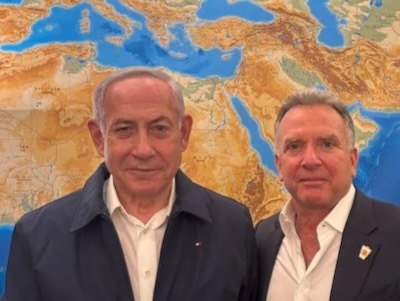 Steve Witkoff did not let himself be fooled by Benjamin Netanyahu. Back in Washington, he warned his friend, President Donald Trump, about the historical fascism of the “revisionist Zionists.”
Steve Witkoff did not let himself be fooled by Benjamin Netanyahu. Back in Washington, he warned his friend, President Donald Trump, about the historical fascism of the “revisionist Zionists.”Meanwhile, President Donald Trump is scheduled to meet with the leaders of Saudi Arabia, the United Arab Emirates, and Qatar this week, but will not meet with Benjamin Netanyahu. Defense Secretary Pete Hegseth also canceled a planned trip to Israel at the same time, reinforcing the president’s message. Reuters revealed on May 8 that Washington, in negotiating with Saudi Crown Prince Mohammed bin Salman (MBS), was no longer making recognition of Israel a precondition for any deal. [9] If confirmed, this would mean that to recognize that the Jewish state has become a racist Jewish state would no longer be a crime in the West.
In early March, it was announced that President Donald Trump had authorized Adam Boehler, his negotiator for the release of the American hostages, to establish direct contact with Hamas, which is still officially considered a “terrorist organization. “On May 12, this change of attitude was rewarded with the announcement of the release of the American-Israeli, Edan Alexander, kidnapped while carrying weapons, on October 7, 2023. Moreover, in early May, rumors of a possible recognition by the United States of the State of Palestine during Donald Trump’s trip to Riyadh spread like wildfire.
[…]
NIH Director Jay Bhattacharya: Time to Shut Down the mRNA Platform

By Baxter Dmitry
Global confidence in COVID vaccines has collapsed—and new NIH Director Dr. Jay Bhattacharya says it’s with good reason.
In a candid livestream, Bhattacharya admitted the public has “woken up” to the serious flaws of the mRNA platform, describing it as not only ineffective, but potentially harmful. His remarks mark one of the strongest rebukes yet from inside the medical establishment.
But according to the NIH director, public skepticism isn’t enough. He says the next step must be decisive action: holding Big Pharma and complicit regulators accountable before more damage is done.
“The next step is [to halt] the mRNA platform itself,” said Bhattacharya during a recent livestream. “The manufacturer has no idea what dose they’re giving, no idea where it goes in the body, and whether they are producing off-target antigens.”
Dr. Jay Bhattacharya is one of the thousands of doctors and scientists who signed the Hope Accord petition last year, which called for the urgent “suspension” of “novel Covid-19 mRNA vaccine products” which are “contributing to an alarming rise in disability and excess deaths.”
Dr. Bhattacharya has already made waves as NIH Director, by all but announcing that the mRNA platform is dead, due to uncontrollable biological factors, which accounted for why so many reported serious adverse events, including death, while others might feel nothing.
Dr. Bhattacharya has called for new research into traditional, inactivated, dead-virus vaccines as the new “gold standard.”
As the Daily Mail reported in February 2025:
“Dr Jay Bhattacharya, who has been nominated to lead the National Institutes of Health (NIH), has backed a petition calling for the mRNA vaccines to be paused and retested…He is one of the signatories of the Hope Accord, which claims there is a ‘causal link’ between the mRNA shots and an alarming rise in excess deaths worldwide.”
Dr. Bhattacharya’s nomination by Trump for NIH Director was confirmed by the Senate on March 25.
Trump Rebukes Apple for Moving iPhone Assembly from China to India

Donald Trump has admonished Apple and its chief executive over the tech firm’s reported plans to source production of US-bound iPhones from India.
The US president said he had a “little problem” with Apple’s Tim Cook, after reports that the company is planning to switch assembly of handsets for the US market from China to India.
“I had a little problem with Tim Cook yesterday,” said Trump, speaking in Qatar on Thursday. Referring to Apple’s recent promise to spend $500bn (£375bn) in the US, he added: “I said to him: ‘Tim, you’re my friend. You’re coming here with 500bn but now you’re building all over India. I don’t want you building in India.’”
The complex manufacturing process behind iPhones involves more than 1,000 components sourced from all over the world, which are largely put together in China. Apple is secretive about details of its production processes but analysts estimate about 90% of iPhones are assembled in the country.
However, production in India has reportedly increased due to trade tensions between Washington and Beijing.
“I said to Tim … we’ve treated you really good, we’ve put up with all the plants that you’ve built in China for years, now you got to build [for] us,” Trump said. “We’re not interested in you building in India, India can take care of themselves … we want you to build here.”
Trump then said Apple was “going to be upping their production in the United States”, although he did not provide further details to back up the claim.
No iPhones are currently made in the US and experts have warned that moving assembly of Apple’s top-selling product to its home country would be impractical and costly. The US financial firm Wedbush Securities has estimated that the cost of an iPhone would treble if assembly were to be shifted to the US.
Apple was approached for comment.
The US president also said on Thursday that India had offered a trade deal that proposed “no tariffs” for American goods.
New Delhi is seeking to clinch a trade deal with the US within the 90-day pause announced by Trump on 9 April on tariff hikes for trading partn
“It is very hard to sell in India, and they are offering us a deal where basically they are willing to literally charge us no tariffs,” Trump said.
India’s prime minister, Narendra Modi, has in recent years promoted his country as a smartphone manufacturing hub.
In March, Apple’s main India suppliers, Foxconn and Tata, shipped nearly $2bn of iPhones to the US, an all-time high, to bypass Trump’s impending tariffs.
[…]
Nightmare of Jerusalem Part III – Iran Unloads All Their Obsolete Missiles on Israel
Nightmare of Jerusalem Part III
Press TV (2025)
Film Review
Part III concerns the actual attack Iran launched on Israel (in retaliation for the April 1, 2024 bombing of their Damascus embassy) on 13 April, 2024. The attacks seems to have had two major goals 1) extreme intimidation of the Israeli government and civilians and 2) a test of ability of NATO and Israel to intercept their missiles. What I found most intriguing about this episode is that they gave Israel, the US and all neighboring territories a 72 hour warning of the missile attack and they purposely used their old, obsolete missiles. Iran specifically stipulated they would call off the attack if Israel committed to ending the genocide in Gaza.
Operation True Promise proved to be extremely cost effective, with Iran spending around $30,000 on their missiles and NATO/Israel wasting roughly $140 million trying to intercept them.
Iran mainly targeted an Israeli spy base in the Israeli-occupied Golan Heights (in Syria), Tel Aviv and Israel’s Nevatim airbase, home to the Israeli plane that bombed Iran’s Damascus embassy.
They fired cruise missiles, Shahed 1369 drones (the type Russians use to strike targets in Ukraine), armed suicide drones (both with a 2,000 km range) and some 1700 km range armed Qiam and Shahed drones specifically aimed at Israel’s defensive system.
Their only goal was penetrating Israeli (and supporters) missile systems, rather than inflicting serious damage.
They achieved both goals. The 72 hour warning caused massive panic buying among Israeli citizens, and at least a third of Iran’s missiles penetrated Israel’s missile defensive system.
May 14, 2025
What to Make of Trump’s Mixed Messages
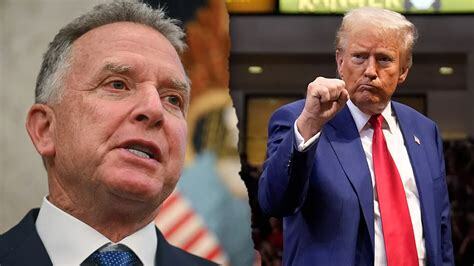 Ted Snider
Ted Snider
In negotiations over wars in areas all over the globe, the Trump administration has been sending inconsistent messages. At times, the statements from the White House are so mixed that it is no longer clear what message the President is trying to send.
Soon after Vice President JD Vance said that the U.S. would not intervene and broker a ceasefire between India and Pakistan, President Trump claimed credit for brokering a truce between India and Pakistan.
“What we can do is try to encourage these folks to de-escalate a little bit, but we’re not going to get involved in the middle of war that’s fundamentally none of our business and has nothing to do with America’s ability to control it,” Vance said.
In the next two days, Vance would call Indian Prime Minister Narendra Modi, and Secretary of State Marco Rubio would be on the phone with officials in India and Pakistan.
President Donald Trump would then post, “After a long night of talks mediated by the United States, I am pleased to announce that India and Pakistan have agreed to a FULL AND IMMEDIATE CEASEFIRE.”
Despite claiming all the credit, the U.S. did not act alone. The Trump administration’s primary involvement was to get the two sides talking, though talks between India and Pakistan were really already taking place behind the scenes. The U.S. was not involved in helping to draft the actual agreement.
Pakistani Prime Minister Shehbaz Sharif credited the United States, saying, “We thank President Trump for his leadership and proactive role for peace in the region.” India has not only not thanked the United States, but they are, reportedly, furious with them. Trump’s announcement caught India by surprise. It preempted India’s announcement that India and Pakistan had spoken for hours and agreed to a ceasefire, and it undermined Modi’s policy that the Kashmir dispute would be resolved through bilateral talks between India and Pakistan. India has downplayed the U.S. role.
On April 22, Trump completed a phone call with Israeli Prime Minister Benjamin Netanyahu, saying that the two “are on the same side of every issue.” He then acted very differently.
On May 6, Trump announced that the U.S. would stop its attacks on Yemen since the Houthis had agreed to stop attacking American ships in the Red Sea. He did not mention if the Houthis would cease their attacks on Israel, and the Houthis made it clear that they would not. According to a senior Israeli official, Israel was not notified of the agreement by the U.S. and was caught by surprise. “We were completely shocked. Israel was not informed before Trump made the statement,” one Israeli official said.
Two days later, the U.S. announced that discussions with Saudi Arabia over cooperation on a Saudi civilian nuclear program that had previously been linked to Saudi Arabia normalizing relations with Israel were no longer linked.
Then, on May 9, a report emerged that the White House was pressing Israel to agree to a ceasefire or be “left alone.”
In Iran, the messaging on the nuclear negotiations became so mixed that it was no longer clear what Washington is demanding from Tehran.
Iran has been clear that negotiations are limited to verifiable limits on its peaceful, civilian nuclear program. Iran’s Supreme Leader, Ayatollah Ali Khamenei, has fully empowered his team to negotiate, but he has placed a firm limit that Iran will not negotiate “the full dismantling of Iran’s nuclear infrastructure.”
Trump has consistently described the meetings the same way: “You know, it’s not a complicated formula. Iran cannot have a nuclear weapon.” Members of his team, though, have not been as consistent. Then National Security Advisor Mike Waltz said that the U.S. is demanding “full dismantlement,” and Trump’s special envoy Steve Witkoff said that “a Trump deal” means “Iran must stop and eliminate its nuclear enrichment and weaponization program.” Rubio said that Iran can have a civilian nuclear program, but by importing uranium enriched up to 3.67 percent and no longer by enriching their own.
The message became truly convoluted when Trump told Meet the Press that the only concession from Iran he would accept was “total dismantlement.” Then, mixing the message even more, speaking in the Oval Office, Trump appeared to walk back that demand, saying, “We haven’t made that decision yet.”
The messaging in the Ukraine-Russia conflict is no less mixed. The Trump team recently presented a “final offer,” not on a 30-day ceasefire, but on a full-blown peace plan. When Ukraine signalled that they wanted the next meeting to continue to focus only on a 30-day ceasefire, Secretary of State Marco Rubio and Steve Witkoff pulled out of the talks.
Trump officials continued to signal a shift from focusing on a 30-day ceasefire to longer-term negotiations. In May, Vance said, “It’s not going to end any time soon…. We got ‘em talkin’. We got ‘em offering peace proposals.” Days later, he said, “The next big step we’d like to take” is having “the Russians and the Ukrainians… actually agree on some basic guidelines for sitting down and talking to one another.”
Then, the administration seemed to pivot again with Trump posting that “The U.S. calls for, ideally, a 30-day unconditional ceasefire,” and that “If the ceasefire is not respected, the U.S. and its partners will impose further sanctions.”
The mixed messaging has left negotiations in a certain amount of confusion. Ukrainian President Volodymyr Zelensky believes he is accepting Trump’s demands by agreeing to a 30-day ceasefire; Russian President Vladimir Putin thinks he is accepting Trump’s demands by offering to “resume direct negotiations” in Istanbul.
Sticking with the competing formulation, Zelensky is reportedly “open to direct talks with Russia… but only if Moscow signs up to an unconditional ceasefire first.” Trump responded with the demand that “President Putin of Russia doesn’t want to have a Cease Fire Agreement with Ukraine, but rather wants to meet on Thursday, in Turkey, to negotiate a possible end to the BLOODBATH. Ukraine should agree to this, IMMEDIATELY.”
In conflict negotiations around the world, the Trump administration has offered mixed messaging that has led to confusion about the terms of negotiations and about which party is rejecting those terms. Time will tell if the messaging is symptomatic of confusion in the Trump administration or if it is part of Trump’s negotiating strategy.
[…]
Via https://original.antiwar.com/Ted_Snider/2025/05/12/what-to-make-of-trumps-mixed-messages/
Trump to control Syria by anctions waivers and could protect Syrian Kurds against Turkish/ Damascus/ISIS/ SNA / Irani and Israeli enemies
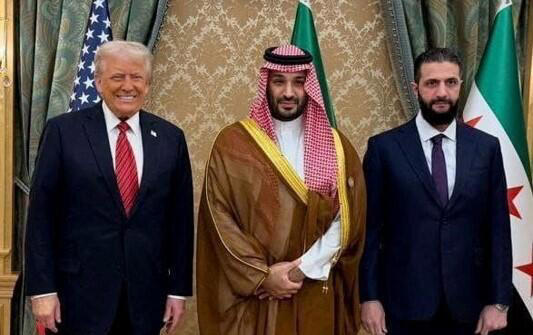
thefreeonline
In a surprise move Trump declared an «end» to the Sanctions throttling Syria, thus taking power of ‘instant reinstatement’ over ‘interim’ ruling ex Al Qaeda terrorists. Reversing the pullout of US bases he also quietly ordered air and logistic support to the Kurdish led SDF battling Turkish led and ISIS attacks
SDF confirms ongoing ‘Coalition partnership’ in Northeast SyriaDAMASCUS, Syria (North Press) – https://npasyria.com/en/125557/– The commander of the Syrian Democratic Forces (SDF) confirmed on Thursday that cooperation between the SDF and the U.S.-led Global Coalition remains active and effective.
Mahmoud Habib, spokesman for the North Democratic Brigade operating under the SDF umbrella, highlighted joint operations carried out against ISIS sleeper cells over the past two days.

In a statement posted on his official Facebook account, Habib noted that both parties have conducted day and night training exercises aimed at enhancing operational and field capabilities.He also reported the establishment of new positions, including in the town of Sirrin, with further deployment planned soon in the Tishrin Dam housing area in southern Kobani.
Habib emphasized that additional military and logistical reinforcements have been sent to support Coalition bases in northern Syria, rejecting reports of an imminent U.S. withdrawal as “baseless illusions.”
On May 3, a source from the Global Coalition told North Press that the U.S.-led forces are conducting their largest military exercises in Syria to date, starting from their bases in the country’s east.
According to the source, the drills are being carried out from the al-Omar oil field base and its surrounding areas in the east of Deir ez-Zor, extending to the Iraqi border.
The source described the upcoming maneuvers as the most extensive since Coalition forces first entered Syria, signaling the start of a new phase of operations against what he termed “malicious organizations.”
By Khalaf Ma’o https://npasyria.com/en/125557/
US sanctions/Tariffs Hegemony wins partial control of HTS led regime in Syria thefreeonline at https://wp.me/pIJl9-GWi
“This will likely be the final end of the Syrian «revolution» with the devastated country parceled out to neoliberal profiteers funded by oil dictators and western corporations.
However it does open the option of the coercive ‘Trump Deal’ ordering an end to the regime permitting mass sectarian massacres, especially of Kurdish, Druze and Alawite minorities.
US coercive control of the economy via sanctions ‘instant renewal’ could in principle curb the ‘bad for business’ persecution of Kurds, Christians, Azeris, Syriacs, ex Assad era workers, LGBTQs… as well as the moves to return women, over half the population, to Al Qaeda/ISIS style servitude.
Sanctions lifting could also be good news for the embattled AANES/SDF area of NE Syria. It seems the US has reversed its policy of partial withdrawal from its bases there which, though only a few thousand troops, maintain Air and Logistical protection against the social revolution’s many sworn enemies.
Latest reports suggest the US has also modified its ‘look the other way’ policy and is now actively resisting Turkey’s genocidal invasions and terrorist attacks, despite it being a NATO partner.
Such reports point to a US deal to enforce a ceasefire in Manbij to curb the killings and looting by Turkish backed SNA mercenaries, as well as the quiet installation of a US post in Kobani to thwart the Turkish backed offensive to destroy the iconic Kurdish city as well as the deal to stop the Turkish sponsored bombing and killing of civilian protestors at the Tishrin Dam.”
North Press also reported that the SDF spokesperson Mahmoud Habib has confirmed the establishment of new US positions, including in the town of Sirrin’s Turkish backed massacre, with further deployment planned soon in the Tishrin Dam housing area in southern Kobani. As the Turkish state continues its genocidal campaign against North-East Syria, which has escalated since the fall of the Assad regime, targeted attacks against civilians have left dozens of people dead or wounded in recent weeks. On January 28, a Turkish UCAV (unmanned combat aerial vehicle) bombed the public market in Sirrin, leaving 12 civilians dead and 13 others wounded.
As the Turkish state continues its genocidal campaign against North-East Syria, which has escalated since the fall of the Assad regime, targeted attacks against civilians have left dozens of people dead or wounded in recent weeks. On January 28, a Turkish UCAV (unmanned combat aerial vehicle) bombed the public market in Sirrin, leaving 12 civilians dead and 13 others wounded.
The Rojava (AANES/SDF) revolutionary example of multi-ethnic local administration and defense, for gender equality, environmental sustainability, and economic governance including communes is an obvious though much hated template for pacifying the current chaotic mess under the new Syrian rulers .
The SDF 80,000+ decentralised coalition of dozens of Kurdish led local, minority, women’s and anti -jihadi, militias are paid by the Autonomous Administration (NOT by the US).
Moves to disband the SDF by integration into the new Damascus state army have been accepted in principle, but the appointment by Jolani of a US condemned HTS war criminal as ‘commander’ to take control of Rojava has raised outraged resistance. The plan to disband may be delayed and reformed indefinitely. See Outrage as Hevrin Khalaf’s killer made Army Leader to destroy Rojava -‘securing the provinces of Hasakah, Raqqa, and Deir Ezzor’-. – The Free )
[…]
Similarly the Trump Sanction Deal and reported reversal of withdrawal from bases raises questions on other concessions by AANES/SDF to the HTS-led ‘interim’ government in Damascus. For example the agreement to withdraw the SDF from the key Tishrin dam defense as SNA Turkish mercenaries in theory come under HTS control.
[…]
Witkoff said to present new plan to free all hostage and remove Hamas from power

White House special envoy Steve Witkoff speaks with journalists after a signing ceremony between President Donald Trump and Qatar’s Emir Sheikh Tamim bin Hamad Al Thani at the Amiri Diwan in Doha, Qatar, May 14, 2025. (AP Photo/Alex Brandon)
US President Donald Trump’s special envoy to the Middle East, Steve Witkoff, has laid out a new plan during hostage negotiations in Doha for a deal to release all the hostages in Gaza and remove Hamas from power in the Gaza Strip, according to a Channel 12 news report.
While mediators have expressed support for the plan, and Hamas has “sent positive signals,” Prime Minister Benjamin Netanyahu is insisting on a limited deal that does not require Israel to end its military campaign in Gaza, says the report.
“The Americans have an attitude of ‘take it or leave it,’ or we’re gone. They are determined that whoever doesn’t go with them will lose a lot,” a senior Israeli official aware of the discussions told Channel 12.
In recordings aired this evening by the network, Witkoff is heard telling the hostages’ families yesterday in Tel Aviv that, “Statistically, many more hostages than not have come out through diplomatic means, that’s what’s really worked. The Israeli military has had success, they have, but more often than not, dialogue and diplomacy have really worked here.”
Meanwhile, members of the Israeli security cabinet told Channel 12 today that “this cabinet approved [Israel’s planned expanded Gaza ground invasion] in the case that Hamas does not agree to release additional hostages in the [original] Witkoff framework. The prime minister will be judged by us based on how firmly he stands up to the pressure from Trump.”
The original Witkoff framework would see a temporary ceasefire of some 40 days, in exchange for about half of the remaining living hostages.
[…]
Saudi FM: US, Saudi Arabia ‘Agree to End Gaza War, Release All Hostages’
By Agencies and ToI Staff Today
Speaking to journalists after the Gulf summit, Saudi Foreign Minister Faisal bin Farhan Al-Saud says that the US and Saudi Arabia “agree to end the war in Gaza and release all hostages.”
He says the US administration is willing to make “very courageous decisions” to push toward a ceasefire in Gaza, and “open up pathways to resolving the broader issues of Palestine,” including “moving toward, one hopes, a Palestinian state,” according to a New York Times report.
The US did not issue a similar statement in regards to any agreements reached with the Saudis about the war in Gaza.
Al-Saud also says, “We need to reach a ceasefire in Gaza as soon as possible,” adding that “without a ceasefire in Gaza, it would be difficult to supply aid” to the enclave.
He also adds that Saudi Arabia “fully supports the US-Iran nuclear talks,” adding that he “hopes for positive results.”
Additionally, he says that the Saudis and the Gulf states “will be the first supporters” of a Syrian “economic renaissance.”
“We want to see Syria build a sustainable economy and build self-sufficiency,” he says. “That all needs a push, and that push will come from its friends in the region and beyond.”
[…]
Digital Prison in the Making: Wikileaks Blasts Palantir for Digital Spying & Gaza Massacre
 Ekatarina BlinovaThe CIA-linked military tech firm thrives under Donald Trump, despite dark controversies. WikiLeaks has outlined a string of warnings about Palantir’s ties to spying, possible war crimes, and human rights abuses.Gaza Killware
Ekatarina BlinovaThe CIA-linked military tech firm thrives under Donald Trump, despite dark controversies. WikiLeaks has outlined a string of warnings about Palantir’s ties to spying, possible war crimes, and human rights abuses.Gaza KillwarePalantir provided an AI-powered targeting tools to Israeli forces that they used in deadly strikes on civilians and aid workers in Gaza, according to The Nation.
Left off the WikiLeaks List? Palantir’s Ukraine AI War LabTime reported that Palantir turned Ukraine into an “AI war lab” in June 2022, offering its services for free.
In February 2023, CEO Alex Karp bragged that Palantir was responsible for “most of the targeting” by Ukrainian forces — whose military has a record of striking residential areas and civilian infrastructure.
Predictive Policing & EU Privacy ViolationsIn 2020, Dutch privacy group SOMI demanded a probe into Palantir’s secretive work with EU police and spy agencies, including Europol and German state police.
SOMI accused Palantir of abusing civilian data and pushing “predictive policing” that undermines the presumption of innocence.
The Verge revealed that between 2012–2018, Palantir ran covert predictive policing programs in New Orleans—without public consent.
ICE Deportations & Family SeparationPalantir’s software has been used by the US Immigration and Customs Enforcement (ICE) for workplace raids, deportations, and family separations, according to Vice and The Intercept.
The Intercept also reported in 2017 that Palantir tools allowed ICE to track US citizens using biometric data and access classified intelligence — even from the CIA.
Branding WikiLeaks a “Threat”WikiLeaks shared what appears to be a 2011 Palantir white paper that explicitly labeled the organization a “threat.”
The document suggests Palantir was keeping surveillance on WikiLeaks’ servers, its founder Julian Assange, and staff members.
It also indicated Palantir’s intent to “capitalize” on WikiLeaks’ vulnerabilities and “combat” the group.
[…]Via https://sputnikglobe.com/20250514/digital-prison-in-the-making-wikileaks-blasts-palantir-for-spying–gaza-massacre–1122052628.htmlThe Most Revolutionary Act
- Stuart Jeanne Bramhall's profile
- 11 followers




